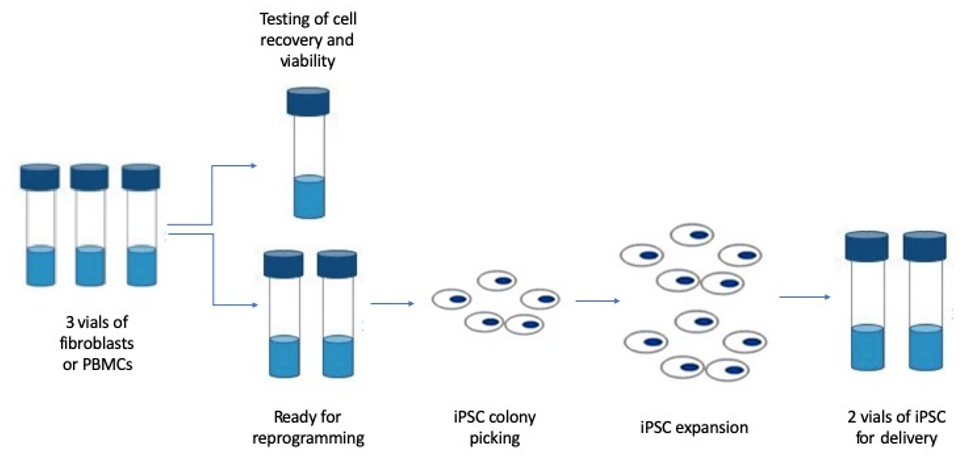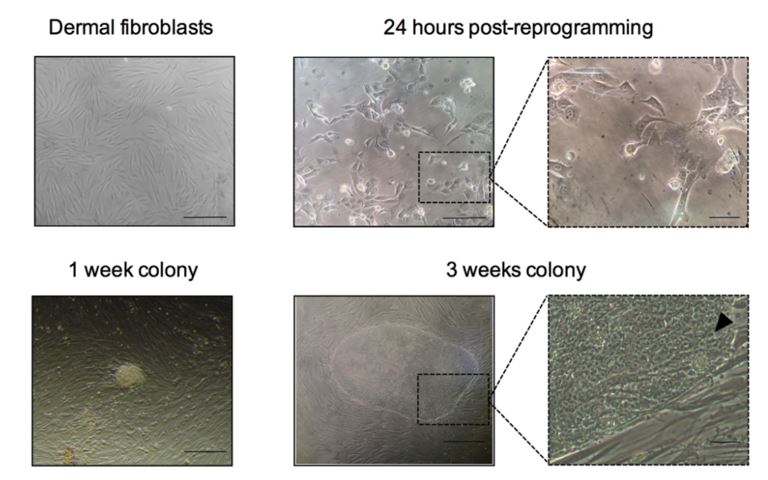iPSC Generation
Compared to primary culture, iPSC-derived cells are amenable to genome editing/engineering and direct control over genetic diversity with the unlimited proliferation potential. Additionally, iPSC derived from peripheral blood or skin fibroblasts can be differentiated into certain cell types which are hard to collect directly from the donors, such as cardiomyocytes, cortical neurons, pancreatic beta cells, etc.
Creative Bioarray is dedicated to providing several viable and cost-effective methods for pluripotent stem cells (iPSC) generation. We employ advanced iPSC reprogramming factor delivery by episomal vectors, viral vectors, as well as other iPSC reprogramming methods (mRNA, protein and chemical reprogramming) to help you obtaining the desired iPSC.
Creative Bioarray offers iPSC generation service:
- Almost 100% rate of reprogramming by optimized protocols
- The passage ratio of iPSC is around 1:15~20, which allows to establish a large amount of cell bank
- Generated from healthy or diseased samples
- From skin fibroblasts, PBMCs, CD34+ cord blood, LCLs, hair follicles and more starting cell samples
- Viable and various Integration-free and feeder-free approaches
- Free characterization assays included, such as ICC, Karyotyping (G-banding), Teratoma Formation assay, RT-PCR for pluripotent gene expression, TaqMan hiPSC Scorecard Assay. Each of these services will be provided with a comprehensive report suitable for publications.
 Figure 1. iPSC Generation service workflow at Creative Bioarray.
Figure 1. iPSC Generation service workflow at Creative Bioarray.
Workflow of iPSC Generation service:
- Recovery, passaging, initial testing and banking of donor cells
- Cell reprogramming with non-integrating, zero-footprint systems
- iPSC colony picking, expansion, and cryopreservation
- iPSC Characterization assays
- Established iPSCs QC tests before release
Samples required: 2-3 vials, 10^6 cells/vial
Deliverables:
- 2 iPSC clones with 2 vials per clone at 10^6 cells/vial
- Project report
Once you receive the iPSCs from us, our dedicated specialists will share their expertise and provide ongoing support to help ease the adaptation of the cells into your experimental systems.
 Figure 2. Example of iPSC reprogramming. Phase contrast images taken after reprogramming, showing the morphological changes occurred after transduction.
Figure 2. Example of iPSC reprogramming. Phase contrast images taken after reprogramming, showing the morphological changes occurred after transduction.
Creative Bioarray is an experienced and outstanding provider of iPSC Generation service. We are dedicated to providing quality data and comprehensive service for your scientific research, and we are pleased to use our extensive experience and advanced platform to offer the best service to satisfy each demand from our customers.
If you have any special need in iPSC Generation service, do not hesitate to contact us for this special service. Please let us know what you need and we will accommodate you. We are looking forward to working with you in the future.
References
- Takahashi, et al. "Induction of pluripotent stem cells from mouse embryonic and adult fibroblast cultures by defined factors." cell 126.4 (2006): 663-676.
- Csöbönyeiová, et al. "Toxicity testing and drug screening using iPSC-derived hepatocytes, cardiomyocytes, and neural cells." Canadian journal of physiology and pharmacology 94.7 (2016): 687-694.

